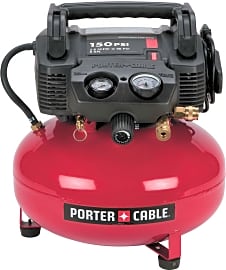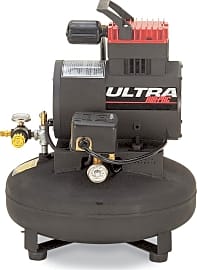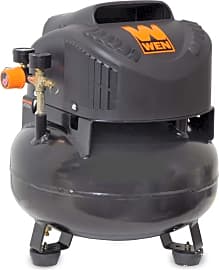The 10 Best Pancake Compressors

This wiki has been updated 43 times since it was first published in July of 2015. Whether you're a hobbyist or professional contractor, you'll appreciate having one of these pancake compressors in your arsenal of power tools. Smaller and lighter than their stacked counterparts, they quickly deliver high volumes of air pressure, making them ideal for operating nail guns and inflating vehicle tires. Always take the relevant safety precautions when operating these devices. When users buy our independently chosen editorial selections, we may earn commissions to help fund the Wiki.
Editor's Notes
May 10, 2019:
Two benefits that most pancake compressors have going for them are their compact sizes and high pressure outputs. Both of these values make them relatively easy to transport and powerful enough to handle a variety of pneumatic tools on the job. They're also great for inflating things like mattresses and car tires. That said, I wanted to make sure that both of these values were well-represented in the list.
I maintained the DeWalt DCC2560T1 for its lightweight design, rubber feet, and heavy-duty roll cage that allows it to withstand impacts sustained at industrial job sites. It also runs on a 20-volt battery, which provides it an additional level of maneuverability over its corded counterparts. I thought the Excell U256PPE was a worthy addition, thanks to its proprietary low-voltage startup capability, which makes it ideal for use in rural settings, places with unreliable power supplies, and in areas with very cold temperatures. Although the Thomas T-30HP is one of the more expensive options, I still included it due to its durable construction and fast recovery times. Also kept the Porter-Cable C2002 for its powerful induction motor and oil-free pump. Maintained the Rolair D2002HPV5 for its splash lubrication system and fast motor speed. I decided to add the Wen 2286 for its super-compact design and dual gauges that let you keep an eye on both its tank pressure and rate of airflow. Finally, the Metabo HPT comes paired with an 18-gauge brad nailer, safety glasses, and a hybrid hose with industrial fittings, making it ideal for woodworking projects.
Picking A Pancake Compressor
In the $100 to $150 range you can find many fine pancake compressors that should suit most needs of the homeowner and/or car care enthusiast.
Anyone wondering why a "pancake compressor" is so called need only take a look at one for their answer: the actual tank wherein air is compressed approximates the shape of a pancake with its round, flat shape. This design allows the pancake compressor to be significantly smaller than standard air compressors, meaning better portability, easier storage, and more convenient use in small spaces, such as a residential garage or workshop.
Most pancake compressors can also be powered by a standard 120 volt AC outlet, which is another reason for their popularity among professionals making house calls and DIY types who are tackling their own projects or repairs. While some pancake compressors might not generate enough air pressure for the largest commercial grade devices, most units are more than adequate for use with anything from a brad nailer to a paint sprayer to helping you top off a vehicle's tire that has leaked some air.
While generally less expensive than full sized air compressors, top quality pancake compressors can still cost close to $350, meaning they are not exactly cheap. On lower end of the cost scale, you can get a pancake compressor for less than fifty dollars, though. As you might expect, with a higher price tag comes more capability and a better build quality.
With a high quality, higher priced pancake compressor, you can expect a unit that easily produces up to 150 PSI (pounds per square inch) of air pressure and that has a tank capacity exceeding four gallons of air. (The larger the tank, the longer the unit can operate before it needs time to re-pressurize itself.) You can also expect a durable machine made with solid parts designed to last for many years of regular use. Many people report getting well over a decade of heavy use out of good quality pancake air compressors, so you end up saving money in the long run when you don't have to replace a cheaper unit that is showing its age.
On the other hand, if you are only going to be using your air compressor a few times a month (or even less -- some people may only use such devices a few times a year, in fact) then there's no real reason to spend top dollar for a compressor unit. In the $100 to $150 range you can find many fine pancake compressors that should suit most needs of the homeowner and/or car care enthusiast. Choose based on features like length of air hose, prominence of display dials, and the accessories that come with the unit (various nozzle types, for example).
And don't overlook weight: many pancake air compressors weigh as much as sixty pounds, making them a burden for many people to move about. Others weigh less than half that.
Under Air Pressure: A Quick Guide
Whether you are filling the tires of your car with air prior to a long road trip or before you haul a trailer; whether you're about to hook up a new nail gun to your pancake air compressor, or if you're about to start using a spray painter to stain a fence, first read up on the right air pressure setting for the task. And that is to say check the vehicle's manual or read the literature that came with the tool in question; this is meant to be a primer on common air pressure settings intended to help inform you if you have tools properly matched with your compressor; it is not meant to serve as the final guide.
As for sporting equipment, the average air pressure for a football used in an NFL game must be between 12.5 and 13.5 PSI.
Generally speaking, though, a nail gun, brad nailer, stapler, and most other tools that drive hardware using compressed air have an ideal operating range of between 90 and 120 PSI. Any force much below the lower end of that range will likely fail to fully sink nails, brads, etc., while forces above that range risk driving the hardware too far into the wood, shingles, or other building material. The other risk you face when air pressure is too high is blowing a seal built into the tool you're using, thereby rendering it useless.
Standard car tires generally have a recommended air pressure range between 30 to 35 PSI. This varies where you are using high performance tires, when winter weather arrives and a bit of extra pressure is often warranted, or when you are going to be towing a vehicle or loading your car's trunk or bed with weight. In these cases, you may need to add a few more pounds of pressure to the rear tires -- never exceed the maximum pressure for which the tires are rated, though.
As for sporting equipment, the average air pressure for a football used in an NFL game must be between 12.5 and 13.5 PSI. Variation in ball PSI can cause sensational issues.
A Few Words On Standard Air Pressure Measurements
While PSI is the most commonly known air pressure measurement standard in the United States, it is but one of the widely used global measurement systems. Knowing a few of the other common standards can help clear up confusion you might otherwise face at times.
Things get confusing quickly here, though: one PSI is equal to roughly 6,894 pascals.
The Metric System uses a logical air pressure measurement standard known as the bar. One bar is roughly equivalent to the average ambient air pressure at sea level, which is created as a result of the earth's gravity acting on the atmosphere. One bar is equal to almost exactly 14.5 PSI.
Another common unit is simple called the standard atmosphere unit of pressure. It is a measurement commonly used in scientific realms and is equal to just less than one bar. In fact, the two measurements are so close that you can think of an ATM as being also equal to 14.5 PSI, thus that pounds per square inch measurement is the piece of data you should try to internalize as a reference point for converting other measurements when they arise.
If you wish to learn more about pressure measurement units, the next unit to study is the pascal, which was named for French mathematician and scientist Blaise Pascal. Things get confusing quickly here, though: one PSI is equal to roughly 6,894 pascals.















